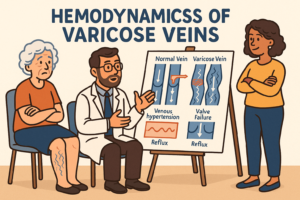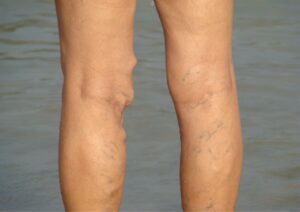Endovenous laser varicose vein surgery, often referred to as endovenous laser ablation (EVLA) or thermal ablation, is a minimally invasive procedure designed to treat varicose veins. Varicose veins are enlarged, swollen veins that typically appear blue or purple and are most commonly found in the legs. EVLA is particularly effective for treating large varicose veins, which are extensive and greater than 6mm in diameter. These veins are caused by weakened or damaged valves within the veins, which leads to poor blood flow and pooling of blood. Symptoms associated with varicose veins include swelling, heaviness, aching, and general discomfort in the affected areas.
The Procedure
The procedure begins with the insertion of a thin catheter into the affected vein under ultrasound guidance. This ensures precise placement and minimizes risks. Local anesthesia is typically administered to numb the area around the vein, though general anesthesia might be used in some cases. Once the catheter is in place, a laser fibre is inserted into the vein to deliver laser or radiofrequency energy directly to the vein wall. This energy heats the vein, causing it to collapse and seal shut.
Laser treatment involves the use of a laser fibre to emit wavelengths of light, applying heat to the vein walls, and gradually withdrawing it from the vein while emitting intense heat.
The heat generated by the laser or radiofrequency energy effectively scars the inside of the vein, leading to its closure. Over time, the treated vein is absorbed by the body, and blood flow is naturally redirected to healthier veins. This improves overall circulation and alleviates the symptoms associated with varicose veins.
What are the risks of endovenous laser varicose vein surgery?
All surgeries have some risks. Some risks of laser varicose vein surgery include:
Infection
Pain over the vein
Bleeding
Bruising
Nerve damage
Redness or swelling (inflammation) of the vein
Blood clots
Changes in skin color over the treated vein
Burns
Deep vein thrombosis
Skin burns
The procedure involves treating superficial veins, which can sometimes lead to complications such as skin burns and deep vein thrombosis.
You may have other risks, depending on your general health. Be sure to talk with your healthcare provider about any concerns you have before your surgery.
Is Endovenous Laser Ablation Painful?
Endovenous Laser Ablation (EVLA) is a minimally invasive procedure used to treat varicose veins. It is generally well-tolerated by patients, but experiences of pain can vary. Here’s an overview of what to expect in terms of pain and discomfort:
Pain During the Procedure
1. Local Anesthesia: The procedure is usually performed under local anesthesia, which numbs the treatment area and minimizes pain. Some patients might feel minor discomfort or a slight sting when the anesthesia is injected.
2. Laser Energy Application: As the laser fiber is inserted into the vein and laser energy is applied, some patients report a sensation of heat or a mild burning feeling. However, this is typically well-controlled with the local anesthesia.
Pain After the Procedure
1. Post-Procedure Discomfort: After the anesthesia wears off, patients might experience mild pain, bruising, or a sensation of tightness in the treated area. This discomfort is usually mild and can be managed with over-the-counter pain relievers like ibuprofen or acetaminophen.
2. Recovery Period: Most patients can resume normal activities within a day or two after the procedure. The pain experienced during recovery is generally minimal, but wearing compression stockings as recommended can help reduce discomfort and support healing.\
Overall Tolerance
Most patients find EVLA to be a tolerable procedure with manageable pain levels. The benefits of reduced varicose vein symptoms often outweigh the temporary discomfort associated with the treatment. If you have concerns about pain, discussing them with your healthcare provider before the procedure can help you understand what to expect and how best to manage any discomfort.
Benefits and Recovery
Endovenous laser varicose vein surgery is recognized for its high success rate and low risk of complications. One of the major advantages of this procedure over traditional vein stripping surgery is its minimally invasive nature. Traditional vein stripping requires larger incisions and general anesthesia, whereas EVLA is performed through small punctures with local anesthesia, significantly reducing the risk of scarring, pain, and complications.
Post-procedure, patients can typically resume normal activities almost immediately. However, some may experience minor bruising, swelling, or discomfort in the treated area. The heat from the procedure may cause inflammation of the vein wall, leading to the formation of a blood clot, which is naturally absorbed by the body over a few weeks. To aid in healing and prevent blood clots, compression stockings are often recommended.
Who Performs the Procedure?
EVLA is usually carried out by interventional radiologists, vascular surgeons, or other specially trained physicians in a vein center or hospital setting. This outpatient procedure does not require a hospital stay, making it a convenient option for many patients.
Effectiveness and Cosmetic Benefits
Beyond alleviating symptoms of venous insufficiency, endovenous laser varicose vein surgery is effective in treating varicose veins and preventing complications such as leg ulcers and blood clots. Additionally, it enhances the appearance of the skin by reducing the visibility of unsightly varicose veins, contributing to improved cosmetic outcomes.
Conclusion
Endovenous laser varicose vein surgery offers a safe, effective, and less invasive alternative to traditional vein stripping surgery for the treatment of varicose veins. By improving circulation and reducing the symptoms and appearance of varicose veins, EVLA can significantly enhance both the health and quality of life of patients. If you are experiencing symptoms of varicose veins, consult with a vascular surgeon or radiologist to explore treatment options, including endovenous laser therapy.
For more information on the procedure, its benefits, and what to expect, consider visiting reputable medical resources or consulting with a healthcare professional.









